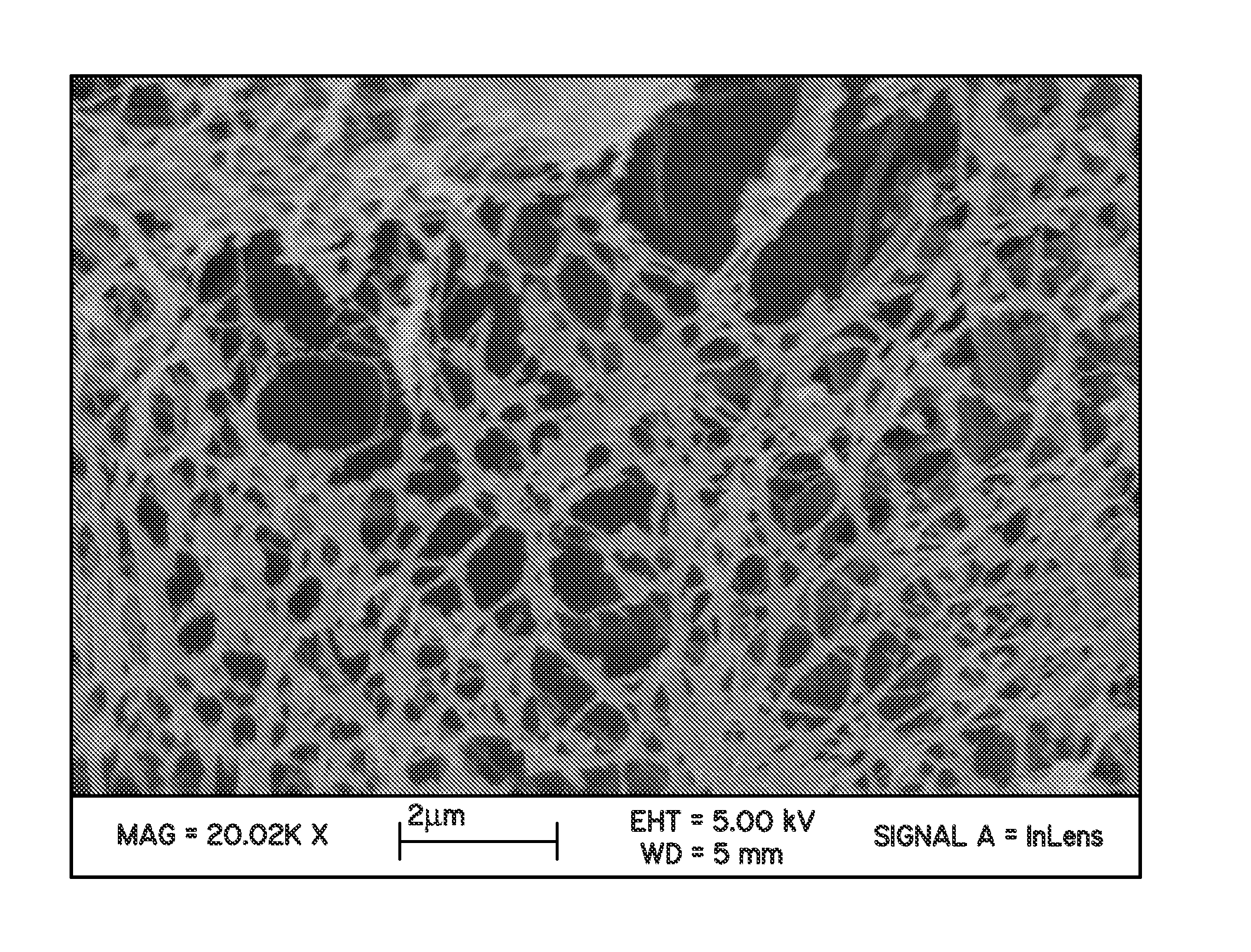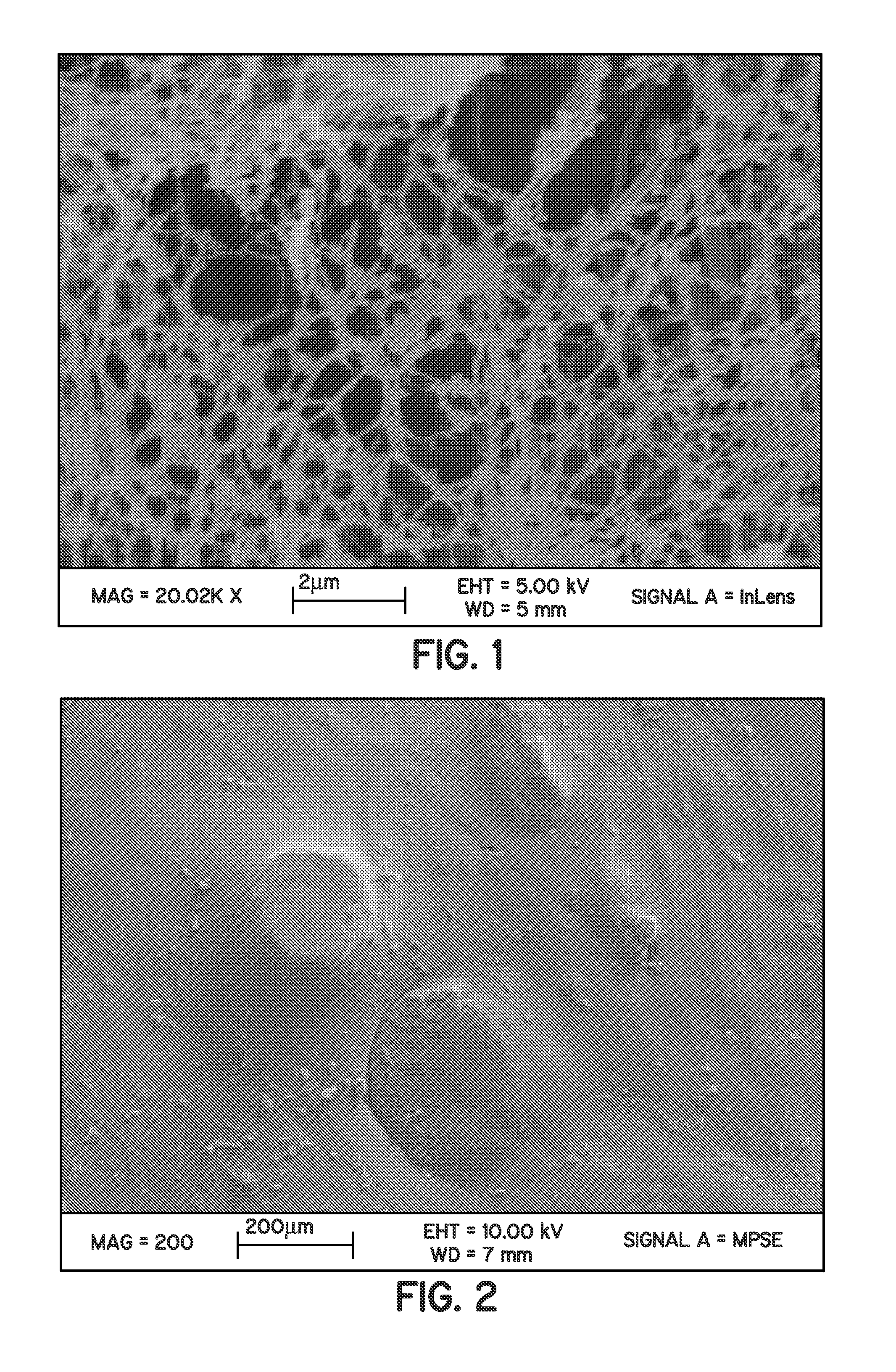Perfluorocyclobutane crosslinked hydrogels
a technology of perfluorocyclobutane and crosslinked hydrogels, which is applied in the field of hydrogels, can solve the problems of pliable or rubbery hydrogels
- Summary
- Abstract
- Description
- Claims
- Application Information
AI Technical Summary
Problems solved by technology
Method used
Image
Examples
synthesis example 1
Blend Synthesis Example 1
[0080]To a 2000-mL beaker equipped with a mechanical stirrer was added 100 g poly(vinyl alcohol), 100 g poly(ethylene-co-vinyl alcohol), and 1100 mL of DMSO. The poly(vinyl alcohol) is 99+% hydrolyzed with an average molecular weight of 124 kDa to 186 kDa and was used as received from Sigma-Aldrich (St. Louis, Mo.). The poly(ethylene-co-vinyl alcohol) was used as received from Sigma-Aldrich and contains 44 mole-percent ethylene. The DMSO was used as received from Sigma-Aldrich and contains ≦0.4% water. The solution was heated to 90° C. for three hours.
[0081]After three hours, the solution was poured into 9″×13″ PYREX dishes heated to 80° C. The solution was allowed to cool slowly to room temperature, and the dish was then placed into a freezer at −30° C. for three hours. The dish was removed from the freezer.
[0082]The resulting material was translucent, flexible, and pliable. To extract the DMSO, 700 mL reagent-grade alcohol (ethanol) was added to the result...
synthesis example 2
Blend Synthesis Example 2
[0083]To a 2000-mL beaker equipped with a mechanical stirrer was added 100 g diol-terminated poly(hexamethylene phthalate), 100 g poly(vinyl alcohol), and 1100 mL of DMSO. The poly(vinyl alcohol) is 99+% hydrolyzed, with an average molecular weight of 124 kDa to 186 kDa and was used as received from Sigma-Aldrich. The diol-terminated poly(hexamethylene phthalate), with an average molecular weight of 1000 Da, was used as received from Sigma-Aldrich. The DMSO was used as received from Sigma-Aldrich and contains ≦0.4% water. The solution was heated to 90° C. for 1.5 hours.
[0084]After 1.5 hours, the solution was poured into a 9″×13″ PYREX dish, covered, and placed in a 60° C. oven for 12 hours. The dish was then placed into a freezer at −30° C. for three hours. The dish was removed from the freezer.
[0085]The resulting material was translucent, flexible, and pliable. To extract the DMSO, 700 mL reagent-grade alcohol (ethanol) was added to the resulting material. ...
synthesis example 3
Blend Synthesis Example 3
[0086]To a 2000-mL beaker equipped with a mechanical stirrer was added 100 g poly(styrene-co-allyl alcohol), 100 g poly(vinyl alcohol), and 1100 mL of DMSO. The poly(vinyl alcohol) is 99+% hydrolyzed with an average molecular weight of 124 kDa to 186 kDa and was used as received from Sigma-Aldrich. The poly(styrene-co-allyl alcohol), with an average molecular weight of 1200 Da, was used as received from Sigma-Aldrich. The DMSO was used as received from Sigma-Aldrich and contains ≦0.4% water. The solution was heated to 90° C. for three hours.
[0087]After three hours, the solution was poured into a 9″×13″ PYREX dish and allowed to cool to room temperature. The dish was then placed into a freezer at −30° C. for twenty-four hours. The dish was removed from the freezer.
[0088]The resulting material was translucent, flexible, and pliable. To extract the DMSO, 700 mL reagent-grade alcohol (ethanol) was added to the resulting material. The material was then allowed to...
PUM
| Property | Measurement | Unit |
|---|---|---|
| molecular weight | aaaaa | aaaaa |
| temperature | aaaaa | aaaaa |
| temperature | aaaaa | aaaaa |
Abstract
Description
Claims
Application Information
 Login to View More
Login to View More - R&D
- Intellectual Property
- Life Sciences
- Materials
- Tech Scout
- Unparalleled Data Quality
- Higher Quality Content
- 60% Fewer Hallucinations
Browse by: Latest US Patents, China's latest patents, Technical Efficacy Thesaurus, Application Domain, Technology Topic, Popular Technical Reports.
© 2025 PatSnap. All rights reserved.Legal|Privacy policy|Modern Slavery Act Transparency Statement|Sitemap|About US| Contact US: help@patsnap.com



